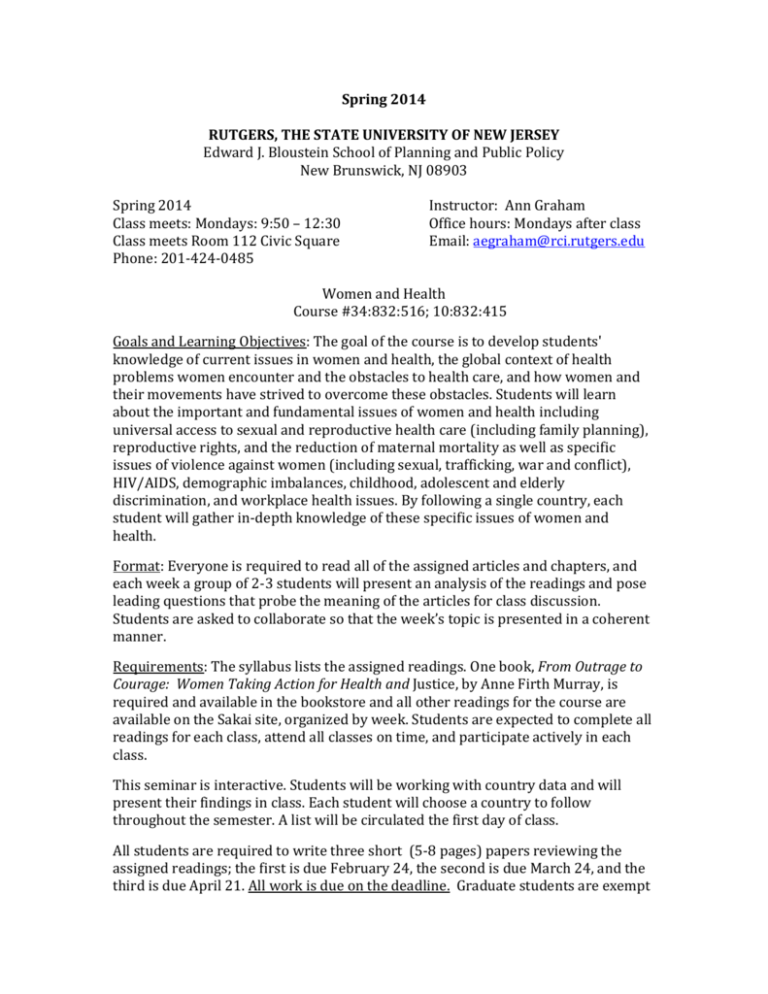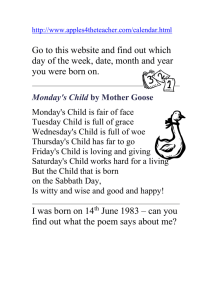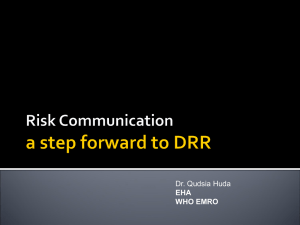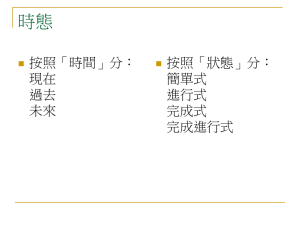516-SP14-Graham-20131217-113644
advertisement

Spring 2014 RUTGERS, THE STATE UNIVERSITY OF NEW JERSEY Edward J. Bloustein School of Planning and Public Policy New Brunswick, NJ 08903 Spring 2014 Class meets: Mondays: 9:50 – 12:30 Class meets Room 112 Civic Square Phone: 201-424-0485 Instructor: Ann Graham Office hours: Mondays after class Email: aegraham@rci.rutgers.edu Women and Health Course #34:832:516; 10:832:415 Goals and Learning Objectives: The goal of the course is to develop students' knowledge of current issues in women and health, the global context of health problems women encounter and the obstacles to health care, and how women and their movements have strived to overcome these obstacles. Students will learn about the important and fundamental issues of women and health including universal access to sexual and reproductive health care (including family planning), reproductive rights, and the reduction of maternal mortality as well as specific issues of violence against women (including sexual, trafficking, war and conflict), HIV/AIDS, demographic imbalances, childhood, adolescent and elderly discrimination, and workplace health issues. By following a single country, each student will gather in-depth knowledge of these specific issues of women and health. Format: Everyone is required to read all of the assigned articles and chapters, and each week a group of 2-3 students will present an analysis of the readings and pose leading questions that probe the meaning of the articles for class discussion. Students are asked to collaborate so that the week’s topic is presented in a coherent manner. Requirements: The syllabus lists the assigned readings. One book, From Outrage to Courage: Women Taking Action for Health and Justice, by Anne Firth Murray, is required and available in the bookstore and all other readings for the course are available on the Sakai site, organized by week. Students are expected to complete all readings for each class, attend all classes on time, and participate actively in each class. This seminar is interactive. Students will be working with country data and will present their findings in class. Each student will choose a country to follow throughout the semester. A list will be circulated the first day of class. All students are required to write three short (5-8 pages) papers reviewing the assigned readings; the first is due February 24, the second is due March 24, and the third is due April 21. All work is due on the deadline. Graduate students are exempt from the third short paper but are required to write a research paper; it is due on . The subject of the research paper is to be cleared with me in advance; an abstract of the research paper and an indicative bibliography are due on March 3. All students are expected to attend classes on time and stay for the double class period; attendance is taken at the beginning of class. Please note that you lose 2 points for each absence not supported by a doctor’s or dean’s note (religious holidays excepted). All absences should be reported on the self-reporting absence log https://sims.rutgers.edu/ssra/. Late arrivals are sometimes unavoidable but they are disruptive; latecomers will lose ½ point off the final grade for each late arrival. Grading: Graduate students’ grades are based on two papers (20% each), the research paper (30%), and presentations, class participation, and attendance (30%). Undergraduate students’ grades are based on the three papers (first 15%, second 25%, third 30%), and presentations, class participation, and attendance (30%). Final grades: 90-100% = A; 85-89% = B+; 80-84% = B; 70-74% = C; 75-79% = C+; 65-69% = D; < 65 = F. ACADEMIC MISCONDUCT: A BLOUSTEIN SCHOOL PERSPECTIVE Academic misconduct includes cheating, plagiarism, failure to cite sources, fabrication and falsification, stealing ideas, and deliberate slanting of research designs to achieve a pre-conceived result. Penalties for misconduct can range from failing an assignment/exam to dismissal from the university. When in doubt about you may consult me or for further information you can go to: http://academicintegrity.rutgers.edu/students.shtml. Academic misconduct almost always happens for two reasons. One is ignorance of academic rules and practices, generally concerning the rules of content attribution, especially as it relates to Internet content. Unfortunately, ignorance is no excuse. Pressure is the second common reason for academic misconduct; if you feel overwhelmed, there are resources available. Ask for help. The Bloustein School plays an important role in the planning and public policy agenda and so our work, our faculty and staff, and our students must be above reproach. Cell phone and laptop policy: Turn off your phone and put it away before class starts. No cell phone, texting, Facebook, email use is permitted in class. Use of laptops is allowed for note-taking only. Please abide by this policy. Outline Week 1: Week 2: Week 3: Week 4: Week 5: Week 6: Week 7: Week 8: Week 9: Week 10: Week 11: Week 12: Week 13: Week 14: Introduction: Why Women’s Health? Population Dynamics Women’s Health, Economic Development and the Environment Education, Empowerment, and Adolescent Health Maternal and Reproductive Health and Family Planning Sexually Transmitted Diseases in Women Violence Against Women as a Public Health Issue War, Conflict and Refugees Fertility and Infertility in the Global Context Food Security, Nutrition and Health Laboring in a Globalized World Aging in a Man’s World Making a Difference and Choosing Priorities: Women’s Actions for Change Student Presentations Week 1: Monday, January 27: Introduction: Why Women’s Health? Introduction to Women’s Health and Human Rights Foreword, Prologue and Chapter 1 of From Outrage to Courage Moss, Nancy E., 2002. “Gender equity and socioeconomic inequality: a framework for the patterning of women’s health, “ Social Science and Medicine 54: pp. 649-661, 2002. Week 2: Monday, February 3: Population Dynamics Why is population and the world’s missing women an issue for issues of women’s health? UNFPA. 2012. Population Matters for Sustainable Development, pp. 1-20. Chapter 2: From Outrage to Courage UNFPA, 2012. Sex Imbalances at birth: Current Trends and Policy Implications, pp. 13-76 Week 3: Monday, February 10: Women’s Health and the Environment What is the impact of energy use, climate change, and choices (or lack thereof) on women’s health? How does women’s empowerment affect the health of their surroundings? Wilkinson, P. et al. 2007. A global perspective on energy: health effects and injustices. Lancet 2007: 370: 965-78. Varkety. 2010. Empowerment of women and its association with the health of the community. Journal of Women’s Health. Vol. 19: No. 1. pp. 71-76. World Bank, 2011. Gender and Climate Change in Bangladesh Week 4: Monday, February 17: Education, Empowerment, and Adolescent Health What are the principal health-related risks of adolescent girls? Why does education matter? Chapters 3 and 4: From Outrage to Courage (except for section on HIV/AIDS) Lloyd, Cynthia. New Lessons: The Power of Educating Adolescent Girls. Population Council, 2009. Chapters 3 and 4 UNFPA, 2012. Marrying Too Young: End Child Marriage read pp 8-58 Bearinger, Linda H. et al, 2007. Global Perspectives on the Sexual and Reproductive Health of Adolescents, The Lancet: 369: March 2007 Case Study: Overlooked and at Risk: Lesbian, Gay, Bisexual and Transgender Youth in the Caribbean: Advocates for Youth, 2010. Week 5: Monday, February 24: *Maternal and Reproductive Health and Family Planning Why do we need to talk about maternal mortality in the 21st century? Gaining a deeper understanding of the interconnectedness of maternal health and empowerment. Chapter 5: From Outrage to Courage Global Health Watch 3. 2011. Maternal Mortality: Need for a Broad Framework of Intervention pp. 124-132 Gawande, Atul, 2013. “Slow Ideas”, The New Yorker, July 29, 2013. Freedman, Lynn P, et al. 2007. Practical Lessons from Global Safe Motherhood initiatives: time for a new focus on implementation. The Lancet, Vol. 370. UNFPA, 2008. Making Reproductive Rights and Sexual and Reproductive Health a Reality for All, read 6-35. Bongaarts, John and Steven Sinding, 2011. “Population Policy in the Developing World”, Science, Vol.333, July 29,2011. pp. 574-575. *First Assignment Due Week 6: Monday, March 3: Sexually Transmitted Diseases in Women The danger of STDs to the health of women and children Chapters 4 section on HIV/AIDS: From Outrage to Courage UNAIDS. UNAIDS report on the global AIDS epidemic. Geneva: UNAIDS, 2013. Low, N, 2006. “Global control of Sexually Transmitted Infections”, The Lancet, 2006: 368: 2001-16. Dworkin, Shari L. and Kim Blankenship, 2009. “Microfinance and HIV/AIDS Prevention: Assessing its Promise and Limitations”, AIDS Behav 13: 462-269. 2009. Week 7: Monday, March 10: Violence Against Women as a Global Public Health Issue Women in a violent world: the most pervasive human rights violation Chapter 6: From Outrage to Courage Jewkes, Rachel et al. 2013. Prevalence of and factors associated with non-partner rape perpetration: findings from the UN Multi-country Transectional study on Men and Violence in Asia and the Pacific, The Lancet, Vol. 1 October 2013. WHO, 2008. Eliminating Female genital mutilation: An interagency statement read p11-21 Week 8*: Monday March 24: War, Conflict and Refugees Disastrous effects of war on women and girls Chapter 7: From Outrage to Courage Samira, Sami et al, 2013. “Responding to the Syrian Crisis: the needs of women and girls,” The Lancet, November 8, 2013 Hynes, H.P. 2004. “On the battlefield of women’s bodies: an overview of the harm of war to women,” Women’s Studies International Forum 27 (5-6):431-445 *Abstract of graduate papers due today Week 9*: Monday, March 31: Fertility and Infertility in the Global Context The globalization of reproduction. Are new technologies empowering or subjugating women? Global Health Watch 3, 2011. “New Reproductive Technologies”, pp. 304-311. Jayaraman, Vinod Mishra and Fred Arnold, 2009. “ The Relationship of Family Size and Composition to Fertility Desires, Contraceptive Adoption and Method Choice in South Asia”, ICF International: Volume 35, No. 1, March 2009. Mascarenhas, Maya et al, 2012. “National, Regional and Global Trends in Infertility Prevalence Since 1990: A Systematic Analysis of 277 Health Surveys,” World Health Organization (WHO), 2012. *Second paper due today Week 10: Monday, April 7: Food Security, Nutrition and Health The right to food is as essential as women’s right to health Bellows AC, Lemke S, Jenderedjian A, Scherbaum V. "A rights-based analysis of gender, nutrition, and structural exclusion: case studies from Georgia and South Africa." Journal Violence Against Women. Forthcoming 2014. De Schutter, Olivier, 2012. “Women’s rights and the right to food, “ Report to the Human Rights Council, United Nations General Assembly, December 24, 2012. Week 11: Monday, April 14: Laboring in a Globalized World Working women: A lifetime of challenge Chapter 8: From Outrage to Courage Miller, Elizabeth et al, 2007. “Sexual Exploitation and Women’s Health: A Case Report from a Community health Center,” Violence Against Women, 13: 486, 2007. WHO, 2006. “ Gender equality, work and health: a review of the evidence”. Read pp. 1-23. WMA. Statement on Violence in the Health Sector by Patients and Those Close to Them, World Medical Journal, November 1, 2012, Vol. 58, Issue 5/6 p 194-196. Week 12: Monday, April 21: Aging in a Man’s World Health consequences of aging after a lifetime of work. Is the health of elderly women a priority? Chapter 9: From Outrage to Courage UNFPA. 2012. Ageing in the Twenty-First Century: a Celebration and a Challenge read pp. 12-33. Katsiki, Niki et al. 2011. “Stroke, Obesity and gender: A review of the literature”, Maturitas 69, 2011. pp. 239-243. “The Plight of nuns: hazards of nulliparity”, 2011. The Lancet Online Tsu, V. 2005. “Preventing cervical cancer in low-resource settings: How far have we come and what does the future hold?” International Journal of Gynecology and Obsetrics, 89: S55-S59, 2005. Malakoff, David, 2011. “Gray Ladies in the Spotlight”, Science, Vol. 333, July 2011. Coughlin et al, 2009. “Breast Cancer as a Global Health Concern”, Cancer Epidemiology, 33, pp. 315-318, 2011. Week 13*: Monday, April 28: Making a Difference and Choosing Priorities: Women’s Actions for Change How do women affect change? Through their own organizations and their influence of social policy Chapter 10: From Outrage to Courage Solar O, Irwin A. 2010. A conceptual framework for action on the social determinants of health. Social Determinants of Health Discussion. Geneva: WHO Paper 2 (Policy and Practice). Read Executive Summary pp 4-9 Molyneux, Maxine and Marilyn Thompson, 2011. “Cash Transfers, gender equity and women’s empowerment in Peru, Bolivia, and Ecuador”, Gender and Development, July 15,2011. (online) *Third Assignment Due Today Week 14: Monday, May 5: Student Presentations/Graduate Papers Due








